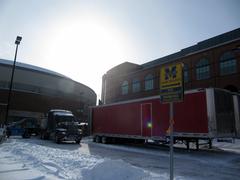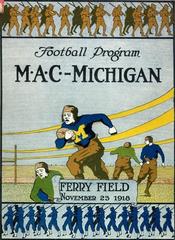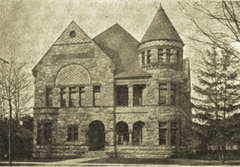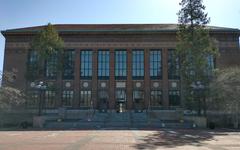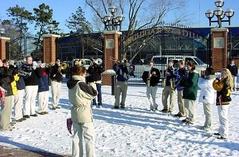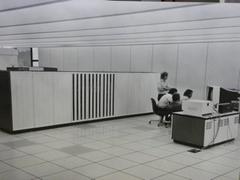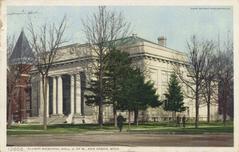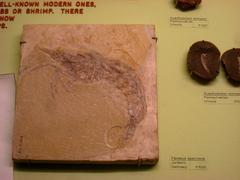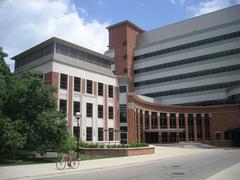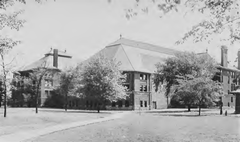The Rock Ann Arbor: Visiting Hours, Tickets, and Historical Sites Guide
Date: 04/07/2025
Introduction
Prominently situated at the intersection of Washtenaw Avenue and Hill Street in Ann Arbor, Michigan, The Rock is a celebrated landmark with nearly a century of history and community engagement. Originally installed as a memorial to George Washington, The Rock has evolved into a dynamic canvas for public expression, embraced by University of Michigan students, Ann Arbor residents, and visitors. This guide explores The Rock’s fascinating origins, its significance as a symbol of free expression, practical visitor information—including accessibility and parking—and its enduring role in Ann Arbor’s civic and cultural life.
Table of Contents
- Introduction
- Historical Origins of The Rock Ann Arbor
- The George Washington Memorial Plaque and Time Capsule
- Visiting Hours, Accessibility, and Parking
- The Painting Tradition: From Memorial to Canvas
- Community, Culture, and Controversy
- Visitor Tips and Etiquette
- Nearby Attractions and Amenities
- Visuals and Media Resources
- Frequently Asked Questions (FAQ)
- Conclusion
- Stay Updated and Further Resources
Historical Origins of The Rock Ann Arbor
The Rock is a large glacial erratic brought to Ann Arbor in 1932 by Eli Gallup, the city’s parks superintendent and an avid rock collector. Gallup discovered the boulder in a county gravel pit and arranged its transport using a Detroit Edison truck. The Rock was placed on a triangular city plot, which became George Washington Park, as part of a memorial commemorating the bicentennial of the first U.S. president’s birth (Bentley Historical Library; Ann Arbor Observer).
A copper plaque was affixed to The Rock in 1939, reading: “To George Washington this memorial erected in celebration of the two hundredth anniversary of his birth, 1932.” A time capsule containing a written history of the memorial is buried beneath the boulder, symbolizing Ann Arbor’s dedication to civic pride and historical remembrance.
The George Washington Memorial Plaque and Time Capsule
Despite economic hardships during the Great Depression, Gallup managed to source enough copper for a commemorative plaque. This shield-shaped insignia faces Washtenaw Avenue and formalizes The Rock’s role as a public monument (Bentley Historical Library). The original inscription, now buried under layers of paint, was last revealed in 1982.
Visiting Hours, Accessibility, and Parking
Visiting Hours:
The Rock is accessible 24 hours a day, 7 days a week, year-round. There are no admission fees or tickets required to visit or paint The Rock.
Parking:
Street parking is available near Washtenaw Avenue and Hill Street, but it fills quickly during university events and weekends. Public parking lots and garages—including the Forest Avenue and South Forest structures—are within a 10–15 minute walk. Ann Arbor parking regulations are strictly enforced (TripMemos).
Accessibility:
The park surrounding The Rock is wheelchair accessible, with paved sidewalks and curb cuts. The immediate area around the boulder is grassy and slightly uneven. Winter conditions may make access more challenging, so caution is advised.
Public Transportation:
The Rock is easily accessible by Ann Arbor’s TheRide bus system, with stops nearby.
The Painting Tradition: From Memorial to Canvas
The tradition of painting The Rock began in the mid-1950s, reportedly initiated after a Michigan vs. Michigan State football game when “M.S.U.” was painted on the stone. This spirited act catalyzed a long-standing tradition of rivalry and public expression (Ann Arbor Observer; Michigan Daily).
Despite initial city efforts to maintain the Rock’s original commemorative appearance, painting became an accepted—and ultimately defining—aspect of its identity. Today, students, local residents, and organizations paint messages celebrating milestones, advocating causes, or simply expressing creativity. The Rock often changes appearance multiple times each week, especially during university events, campus activism, and local celebrations (AnnArbor.com).
Community, Culture, and Controversy
Cultural Role:
The Rock serves as an open platform for expression, welcoming participants from all backgrounds. It is a focal point during university Welcome Week, Homecoming, graduation, and local rallies. The Rock has hosted messages supporting social justice, LGBTQ+ rights, environmental causes, and community celebrations (AADL; LSA News).
Controversies:
The tradition is not without challenges. Some nearby residents have voiced concerns over noise, litter, and environmental impact. The city has invested in park maintenance and graffiti removal to preserve the surrounding area (AnnArbor.com). In the early 1990s, environmental testing confirmed that contamination around The Rock was within safe levels, and the landmark was preserved.
Visitor Tips and Etiquette
- Painting: Anyone is welcome to paint The Rock. Tradition holds that groups paint late at night or early morning for their messages to remain visible longer.
- Respect: Avoid painting over fresh artwork if a group is present or if the message is for a memorial or special event.
- Clean-Up: Bring trash bags to collect empty paint cans and brushes. Littering is discouraged.
- Safety: Use caution near the busy intersection, especially at night.
- Noise: Keep noise levels low to respect nearby residents.
- Content: While there are no official restrictions, messages should be positive, inclusive, and respectful.
- Photography: The Rock is a favorite photo spot. Always ask permission before photographing individuals painting or celebrating events.
Nearby Attractions and Amenities
- University of Michigan Campus: Steps away from The Rock, including central campus landmarks like the Michigan Union and the Law Quadrangle.
- Downtown Ann Arbor: Shops, restaurants, and cultural venues are within walking distance.
- Ann Arbor Hands-On Museum and University of Michigan Museum of Art: Nearby for a more comprehensive Ann Arbor experience.
- Restrooms and Food: No facilities at The Rock itself; restrooms and refreshments available in campus buildings and local businesses.
Visuals and Media Resources
Explore high-quality images and videos of The Rock via the Bentley Historical Library and Ann Arbor photography collections. For virtual tours and interactive maps, visit the city’s official tourism and parks websites.
Frequently Asked Questions (FAQ)
Q: Are there visiting hours or entrance fees for The Rock?
A: The Rock is open 24/7 with no admission charges.
Q: Who can paint The Rock?
A: Anyone! Painting is open to the public and part of local tradition.
Q: Is the site wheelchair accessible?
A: The area is generally accessible, though the terrain may be uneven in places.
Q: Are there restrooms nearby?
A: No, but facilities can be found in nearby campus buildings.
Q: Are there guided tours?
A: While there are no tours specifically dedicated to The Rock, some Ann Arbor and University of Michigan tours include it.
Q: When is the best time to visit?
A: Spring and fall offer pleasant weather; early mornings and late evenings are quieter.
Conclusion
The Rock in Ann Arbor seamlessly blends historical significance with vibrant, contemporary culture. From its origin as a George Washington memorial to its current status as a communal canvas, The Rock invites everyone to participate in Ann Arbor’s ongoing story. Whether you’re admiring its colorful layers, leaving your message, or simply reflecting on its legacy, The Rock is an essential stop for understanding the city’s unique spirit.
Stay Updated and Further Resources
Plan your visit to The Rock today! For guided tours, event updates, and local tips, download the Audiala app. Follow us on social media for the latest news, and explore related articles to make the most of your Ann Arbor experience.
References
- The Rock and Its Role, 2023, Bentley Historical Library (Bentley Historical Library)
- The Rock Ann Arbor, 2025, Ann Arbor Observer (Ann Arbor Observer)
- A Campus Tradition: Painting The Rock, 2024, Michigan Daily (Michigan Daily)
- The Rock May Be Fun to Paint, But It’s a Pain for City Residents, 2024, AnnArbor.com (AnnArbor.com)
- George Washington Park - The Rock, 2024, Ann Arbor Parks and Recreation (Ann Arbor Parks)
- Tips for Game Day at Michigan Big House, TripMemos (TripMemos)
- 11 Iconic Landmarks to See in Ann Arbor, TouristSecrets (TouristSecrets)
- Things to Do: University of Michigan Campus, Awesome Mitten (Awesome Mitten)
- Gameday Guide to the Big House, Ann Arbor Destination Blog (Ann Arbor Destination Blog)
